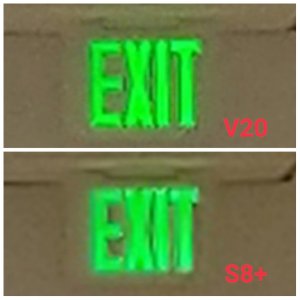Well, this post is going to be a long one. So sit back, relax and grab a cuppa because you're about to learn something you probably haven't seen before.
I can understand why one would think a camera with a higher megapixel count would do better than a lower megapixel count. That's because megapixels denote a camera's resolution, with a megapixel being approximately 1 million pixels. It's not hard to know that in theory, a camera with a resolution of 21 million pixels will resolve more detail than a camera with 12 million pixels. It's part of the reason why people seem to think 21MP is undoubtedly better than 12MP.
However, this is a basic fundamental judgement error people often make. Cameras are not always about one parameter (in this case, resolution or megapixel count). Instead, they're more about multiple factors such as;
- Lens quality: The quality of the lens denotes how sharp an image could be, especially around corners, and good quality lenses will have less artifacts such as fringing and chromatic aberrations.
- Sensor size: The actual size of the camera's image sensor.
- Pixel size: The actual size of each individual photodiode. This relates to MP count and sensor size
- DSP: Known as a digital signal processor, this is the stuff that makes the automatic wizardry in your camera work.
- Processing: How a camera processes a RAW file from the sensor into a compressed JPG matters since techniques differ from manufacturer to manufacturer.
- Aperture f-stop: Denotes how big an aperture is in relation to a camera's focal length. Do note that an aperture of f/1.8 is not universally similar since it differs in relation to the focal length of a camera.
- Stabilization: Helps stabilize a shot in order to reduce blurriness or increase exposure times in non-ideal lighting environments. Can either be optical or digital.
These aren't everything that makes a camera, but they're among the most critical.
Now, back to this.
Let's take the V30's 16MP main camera and dissect it for a bit.
The V30's main camera sensor is an Exmor IMX351, a backside-illuminated CMOS image sensor with an effective resolution of approximately 16MP on a 4:3 aspect ratio. On paper, that sounds fine, but here's the kicker. The sensor size is among the smallest on any flagship phone, at a mere 1/3.1", and as a result, the sensor size is probably the smallest, at 1 micron. For comparison, the iPhone X is around 1.22 microns, the Huawei Mate10 is 1.25 microns on its main camera, and the Pixel 2 XL, Galaxy Note8, HTC U11 and a Moto G5+ pack 1.4 micron pixels and have the largest sensors in this lot (1/2.6" vs 1/2.9" on the Huawei, 1/3" on the iPhone and 1/3.1" on the V30).
At first glance, that doesn't seem too big right? Like what does pixel and sensor size have to do? Well,
quite a lot actually, moreso than megapixels.
The job of a photodiode is to capture light and resolve that light info into digital data that can be processed by the DSP into a suitable JPEG (although one can skip the JPEG processing if one wants to edit the RAW files in Lightroom). Here's where the problem lies. Smaller photodiodes are less capable of sensing light, and when they're packed so closely together, there is a tendency for them to "bounce around" or crosstalk, sometimes causing patches of weird color noise that you see in some RAW shots taken in very low light. While this problem isn't as noticeable in daylight, the smaller photodiode size also means they're more likely to be "flooded" with patches of higher exposures in contrast to lower ones. Which is why you sometimes see blowouts in highlights, mainly due to the photodiodes' limited ability to resolve detail. It also bears mentioning that because they're less capable of sensing light, the ISO would have to be jacked up as well, increasing luminance noise.
So in your particular case, I'd wager that the 16MP sensor wouldn't immediately be a clear victor, mostly because the noise-reduction has to work extra hard to curb some of the increased noise levels due to the smaller photodiodes caused by a combination of a higher resolution on a smaller sensor. The f/1.6 aperture can help but it serves more to balance out the drawbacks. If anything, the output probably won't be much different from that produced by a U11 or Note8.
Reason why most of the OEMs seem to have stuck with 12MP is because on the limited size on phone sensors, 12MP offers a good balance of detail, noise, dynamic range and luminance. It's also why companies have stopped chasing for more pixels and have instead looked to either dual-camera solutions or increasingly sophisticated post-processing techniques via computational means, with a famous example being Google's HDR+, popularized by the 2016 Pixels and recently made their way onto more phones with the help of XDA.
It's also worth noting that this isn't a problem on actual cameras due to their actual size. They pack massive sensors, so it is possible to cram in a ton of pixels without compromising on the actual shot. I'm not kidding when I say a Sony Alpha a7R Mark III is better at actual photo output than a Pixel 2 XL almost solely due to its sensor since it is bigger, has a higher resolution all while packing in significantly larger pixels. Phone cameras don't share this luxury due to limited space, so it's always a balancing act.
TL;DR version: MP doesn't matter as much now. That 16MP moon shot probably wouldn't look much different on a Pixel 2 XL.





